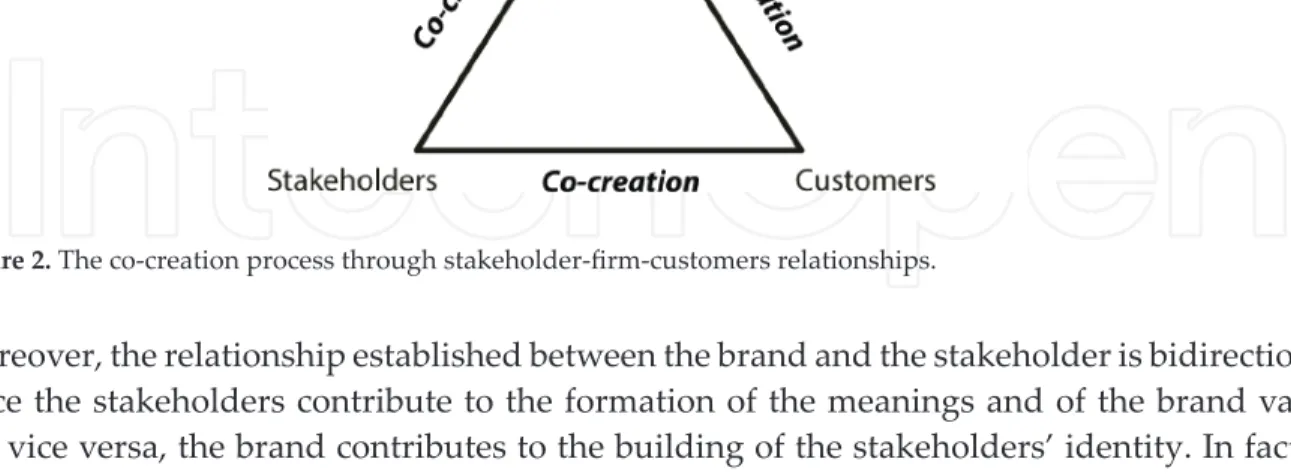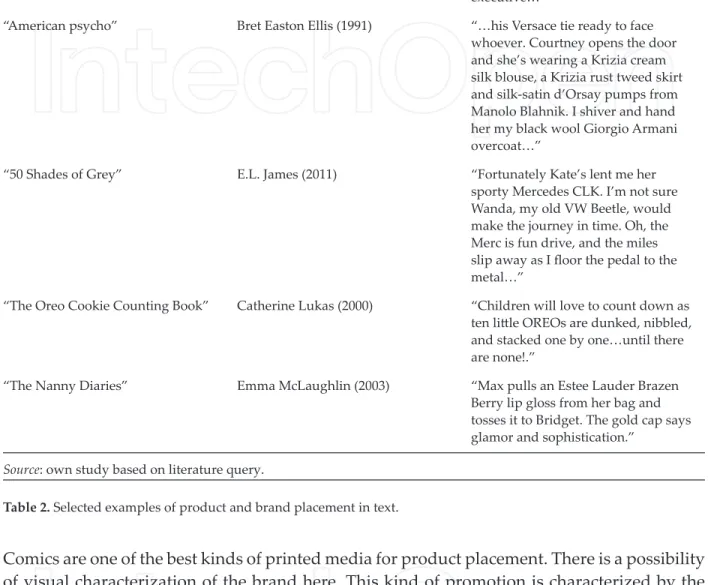Brand value is embedded in products, and consumers are passive subjects, the target of the company's offering and outside the value creation process. In the relationship-focused phase, the brand is analyzed in light of the relationships established between the company and customers, between the customer and the brand [36, 37] and between the company and the brand [38, 39]. The mechanism for determining brand value is in the perceived utility value of the brand, which is determined by all stakeholders.
In terms of brand value, this means that the brand's meanings must be coherent not only with the expectations of the customer, but also with those of all its stakeholders.
![Figure 1. The evolutionary phases of brand logic. Source: Merz et al. [6].](https://thumb-ap.123doks.com/thumbv2/1libvncom/9202498.0/7.918.127.801.254.638/figure-evolutionary-phases-brand-logic-source-merz-et.webp)
Some managerial implications
Brand value creation in the online context
For consumers, it is the minimization of the risk of purchasing specific goods or services, the reduction of research and comparative evaluation costs, the increase in confidence in the company and its offerings [60]. Companies must therefore activate and participate in these relational processes in order to master the processes of formation of brand meanings, aware that they represent only one of many actors in the whole value co-creation process. 24] shows that the discussion sites generated by the company are more effective and have more influence on the online brand building than the discussions conducted by the third party.
So the companies need to play an active and positive role in the creation and management of the discussion pages and closely monitor what happens in these virtual communities.
Conclusion
Each of these topics has an important role in defining the meaning of the brand and the resulting brand value from multiple perspectives. As a consequence, it is necessary for companies to develop broad relational skills with all their stakeholders, being very careful about the inevitable prioritization of brand expectations. In conclusion, based on the assumption that brand meanings and brand value originate from co-creation processes and not one-sided creation processes, there is a large space in the chapter devoted to the analysis of the brand value creation process in the online context. .
It follows that brand communities should be considered a fundamental means of marketing communication in construction.
Notice
Author details
Using a hierarchy-of-effects approach to measure the effectiveness of corporate social responsibility in generating goodwill towards the firm: Financial versus non-financial effects. Making it better: When, why, and how consumers respond to corporate social initiatives. Managing the co-created brand: Value and cultural complementarity in online and offline multi-stakeholder ecosystems.
A selection of our books indexed in the Web of Science™ Core Collection Book Citation Index (BKCI).
TOP 1%
Product Placement as an Effective Tool for the Brand Positioning
Product Placement as an Effective Tool for the Brand Positioning
Introduction
The purpose of this chapter is to present selected aspects of product and brand placement as an unconventional brand positioning tool. Special attention will be paid to defining product and brand positioning and presenting its role in creating brand value for customers. Examples of successful brand positioning through promotional display of products will be presented with selected results of secondary and primary consumer research.
Brand positioning and its role in product and brand placement
In this aspect, the brand must be seen as a multidimensional design that integrates the physical and intangible characteristics of the product and is composed of three elements: the brand image (the way the consumer perceives the brand), brand identity (the way the creator of the brand wants the brand to be seen), and the brand positioning (brand positioning in the market) [11]. A comprehensive approach to the brand stems from the fact that consumers perceive products by associating the brand with all the qualities experienced through the purchase and use of the product. Trademark allows the identification of the product, ensuring the characteristics that distinguish the brand from the other brands.
The information function of the brand is carried out in a direct way (the information is contained in the name and logo of the brand) or indirectly (information based on associations and suggestions regarding benefits) [16].
![Figure 1. The brand iceberg. Source : [12].](https://thumb-ap.123doks.com/thumbv2/1libvncom/9202498.0/23.918.107.808.797.1210/figure-brand-iceberg-source.webp)
Branded product
Product placement as one of the unconventional promotional tools
- Product and brand placement: definition
- Advantages and disadvantages of product placement
- The effectiveness of product placement
- Product and brand placement: movie
- Product and brand placement: printed publications
- Product and brand placement: video games
Product Placement as an Effective Brand Positioning Tool http://dx.doi.org/10.5772/intechopen.69989 29. Product Placement as an Effective Brand Positioning Tool http://dx.doi.org/10.5772/intechopen .69989 . 31. Although product promotion is an effective marketing communication tool, it is not without its drawbacks.
An alternative to the traditional forms of advertising - product placement, unlike television communication, does not affect the interruption of the broadcast. Bad placement - the reception of product placement depends on the screenwriters who bring a brand to the film. Be ahead of the curve – the introduction of product placement takes place on stage in the scenario in the case of feature films, which can even be a few years before shooting.
Product Placement as an Effective Brand Positioning Tool http://dx.doi.org/10.5772/intechopen.69989 33. Ignorance of brand placement leads to uselessness of product placement as a marketing communication tool. Product Placement as an Effective Brand Positioning Tool http://dx.doi.org/10.5772/intechopen.69989 35.
Each of the stories has its own main plot, but a common element is increasingly emerging: product placement. Product Placement as an Effective Brand Positioning Tool http://dx.doi.org/10.5772/intechopen.69989 37.
![Figure 4. Product placement as a mixed form of promotion. Source : [78].](https://thumb-ap.123doks.com/thumbv2/1libvncom/9202498.0/32.918.130.787.239.593/figure-product-placement-mixed-form-promotion-source.webp)
Conclusion
Research conducted in 2010 shows that interactive brand placement has a positive effect on mind awareness, brand image and behavioral intention, which means that brand placement in the virtual game can affect the information assimilation process. In summary, product and brand placement will thrive in prescribed media while introducing new media collateral that will reach a wider range of consumers. This is why, it is so important to understand how the product placement system works.
In the near future, some research efforts will be undertaken which will help in understanding the mechanism of fire placement and how it works from within. Product Placement as an Effective Tool for Brand Positioning http://dx.doi.org/10.5772/intechopen.69989 39. Product Placement as an Effective Tool for Brand Positioning http://dx.doi.org/10.5772/intechopen .69989 41.
Available at: http://www.msi.org/reports/brand-equity-a-perspective-on-its-meaning-and-measurement/ [Accessible. 75] Directive 2010/13/EU of the European Parliament and of the Council of 10 March 2010 on the coordination of certain provisions laid down by law, regulation or administrative action of the members of the European Union concerning the provision of audiovisual media services (Audiovisual Media Services Directive), Official Journal of the European Union, L article 1, paragraph 1. Product placement as an effective tool for brand positioning http://dx.doi.org/10.5772/intechopen.69989 43.
Product Placement as an Effective Brand Positioning Tool http://dx.doi.org/10.5772/intechopen.69989 45.
Service Branding: Suggesting and Discussing Four Perspectives Influencing a Value-Creating Service
Perspectives Influencing a Value-Creating Service Brand at the Company Level
- Literature
- Concepts 1. Value creation
- An actors approach to service branding
- A research perspective
- Findings
- A customer perspective
- A management perspective
- A service employee perspective
- A knowledge perspective
- Model and discussion
- An interactive model of a value-creating service brand
- Implications
- Theoretical implications
- Practical implications
- Conclusions
Which perspectives are useful and applicable in the development of a value-creating service brand at company level. The third section provides an outline of four perspectives that, we argue, can contribute to a value-creating service brand at the company level. The triangle in figure 1 then serves as a framework to represent perspectives of a value-creating service brand at the company level.
Building on and finding support in service branding knowledge and theory, this chapter proposes and discusses four interrelated perspectives that can influence a value-creating service brand at the corporate level. By finding support in service branding knowledge and theory, we propose four perspectives that can have a positive influence on the development of a value-creating service brand at company level. Supported by knowledge theory, we will argue that a knowledge perspective is required to develop a value-creating service brand at company level.
Thus, explicit and tacit knowledge can affect an organization's ability to develop a value-creating service brand. As argued, Model 2 outlines four perspectives for the development of a value-creating enterprise-level service brand. First, by building on knowledge and theory about service and service brands, four different perspectives directly influence the creation of a value-creating enterprise-level service brand.
In this section, we theorize how a value-creating service brand can be achieved at the corporate level by valuing the four interrelated perspectives outlined and discussed in this chapter. Theoretically, Figure 3 shows the connection between service and management/leader orientation in the creation and development of a value-creating service brand. Theoretically, Figure 4 shows the connection between service and customer orientation in the creation and development of a value-creating service brand.
To contribute to the existing knowledge base, we have examined four perspectives of a value-creating service brand at the level of the individual service company.
![Figure 1 shows a relational system in which the customers are important in the creation and development of a value-creating service brand as they are co-creators of the service brand [ 35 ]](https://thumb-ap.123doks.com/thumbv2/1libvncom/9202498.0/51.918.141.781.922.1195/figure-relational-customers-important-creation-development-creating-creators.webp)
Critical Success Factors in Strategic Brand Management in Luxury Fashion Markets: The Case of Isaia
- Theoretical background
- Brand management and consumer‐brand relationships
- Luxury fashion brands
- Conceptual framework
- Case study: Isaia
- Company profile
- Managing the critical successful factors: customization, event marketing and the flagship stores
- Discussion
In the following subsections, we provide a brief literature review of the three critical success factors according to which branding in the luxury fashion industry must be monitored if a firm wants to improve its brand relationships with consumers. In the service literature, more recent works have focused on the importance of the environment. The effect of the physical atmosphere on consumer behavior is therefore mediated by the consumer's emotional state.
In the service and retail literature, several studies have shown that the perceived quality of the physical environment influences con‐ In the luxury fashion industry, the store is regarded as one of the most important necessary elements. The Isaia experience in the flagship stores is in line with the key elements of the company philosophy: details, innovation, tradition and differentiation.
In the service and retail literature, several studies have shown that the perceived quality of the physical environment influences consumer behavior [56]. They want to be part of the consumption process and experience unique and customized purchases. In the specific context of the luxury fashion industry, the theoretical background and empirical evidence demonstrate the need to work on relationships between consumers and brands to improve the shopping experience, and the need for co-creation of value between the brand and the consumer. consumer .
The present work examines the role of brand management in creating strong consumer-brand relationships in the context of the luxury fashion industry by proposing some marketing tools as critical success factors. Perceived value of the mass-customized product and mass-customized experience for individual consumers.


![Figure 3. The daisy wheel of brand equities. Source: Jones [5].](https://thumb-ap.123doks.com/thumbv2/1libvncom/9202498.0/12.918.135.782.747.1202/figure-daisy-wheel-brand-equities-source-jones.webp)
![Figure 2. The product and the brand. Source : [13].](https://thumb-ap.123doks.com/thumbv2/1libvncom/9202498.0/24.918.113.813.819.1187/figure-product-brand-source.webp)
![Figure 3. Participation of the brand in the creation of competitive advantage. Source : [57].](https://thumb-ap.123doks.com/thumbv2/1libvncom/9202498.0/27.918.108.811.650.1202/figure-participation-brand-creation-competitive-advantage-source.webp)
![Figure 5. Model assessing the impact of product placement. Source : [80].](https://thumb-ap.123doks.com/thumbv2/1libvncom/9202498.0/35.918.150.785.246.1038/figure-model-assessing-impact-product-placement-source.webp)

![Figure 6. Factors encouraging the placement of brands in digital games. Source : [98].](https://thumb-ap.123doks.com/thumbv2/1libvncom/9202498.0/38.918.113.802.291.730/figure-factors-encouraging-placement-brands-digital-games-source.webp)